
54 Users Online
Revision: 20141010_080036 | All Revisions
The Umarex XBG and the Combat Zone Enforcer are two very similar guns. In fact, they are the same gun, if you ignore the difference in inner barrel size. The former shoots standard 0.177" metal BB's, while the latter shoots standard 6mm airsoft plastic BB's. But other than that difference, there is no practical difference between the two.
The Umarex XBG and Combat Zone Enforcer are replicas of the Springfield XDM. The original firearm is manufactured in the city of Karlovac, Croatia by HS Produkt and is called HS2000. It is licensed by Springfield Armory in the U.S. Umarex XBG and Combat Zone Enforcer look very cool. They have a futuristic science fiction look to them.
In this article, we will thoroughly review these two air pistols, side-by-side. We will also throw in the review of the Umarex carbine conversion kit for these two pistols as a real bonus.
The Umarex XBG Carbine comes in an excellent box (see photo below). The box is not only well designed and pleasing to look at, but it is close-able, so that you can use it to store the BB pistol and the carbine conversion.
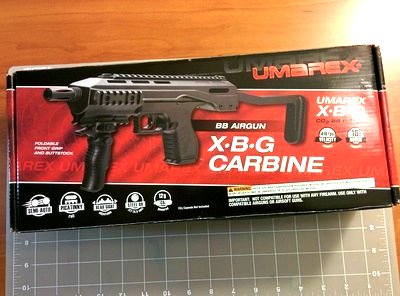
The XBG pistol and carbine is stored neatly and orderly inside the box (see photo below). It really feels like Umarex has placed quality in its top priority list.
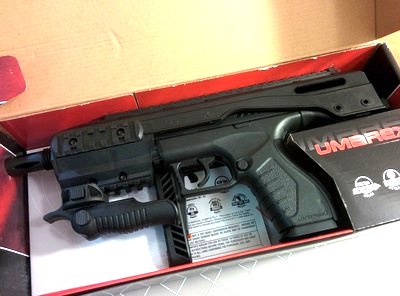
The Combat Zone Enforcer comes in a blister pack (see photo below), which you have to cut through to remove everything. The packaging is well designed and looks great.
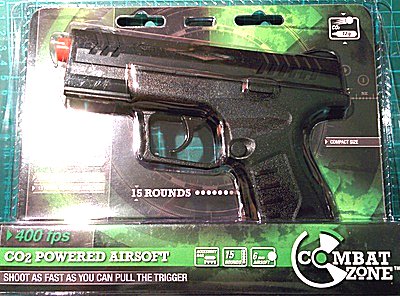
After cutting through the packaging, you'll find the pistol, magazine, a bag of yellow BB's, and instruction manual (see photo below).
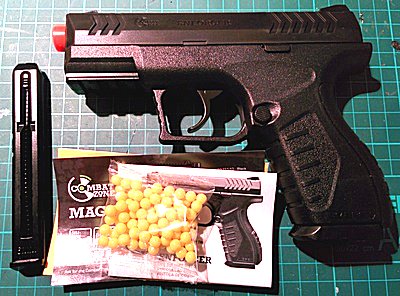
The two pistols are absolutely identical. The only difference is that the airsoft version has an orange tip on it. Otherwise, you can see from the two photos below that there are no differences.


The only other visible difference is the name and BB specification (see photos below) that are engraved on the two air guns.

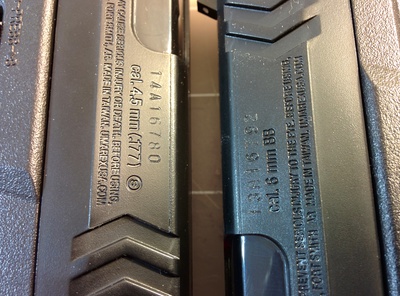
The only external difference between the two air pistols are the front nozzle (see photo below). The XBG BB pistol is not mandated by law to require the orange tip. The Combat Zone Enforce needs the orange tip for commerce per federal law. Both guns have lower Picatinny rails for you to attach accessories.
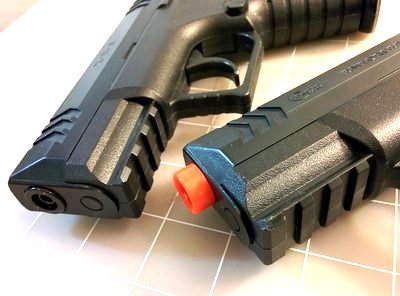
The safety switch is in a strange awkward position. It is on the right, above the trigger (see photo below). So you'll have to use your index (trigger) finger to active it. Pull it back to put it into semi-auto firing mode. Push it forward for safety. The safety switch differs from the real HS2000 firearm. The HS2000 has a rear grip safety, which is very similar to the M1911 pistol.

The font iron sight has a bright white dot, while the rear iron sight is unmarked (see photo below). But they are pretty typical of iron sights on pistols.

The XBG magazine and the Combat Zone Enforcer magazines are almost exactly identical. The only difference is that one is for metal BB's and the other one is for plastic BB's. The photo below shows that the only difference on the front side of the two magazines are the identifies for the type of BB's it accepts.
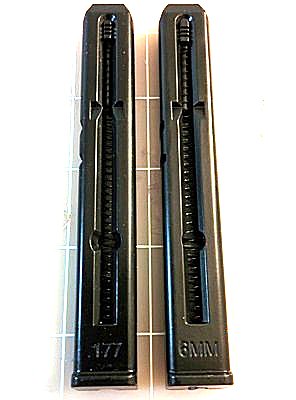
The back of the magazines are also exactly identical as shown in the photo below. The two magazines are so similar that you can insert either magazine into either gun and they will fit fine. Of course, you won't be able to actually use them in the wrong gun, because the BB sizes are different.

When you slide the spring all the way down, it locks in place, allowing you to load BB's through the circular opening. Once you have finished loading BB's, push the little nipple at the bottom of the magazine (see photo below) upward and the spring loaded plunger will spring back upward.
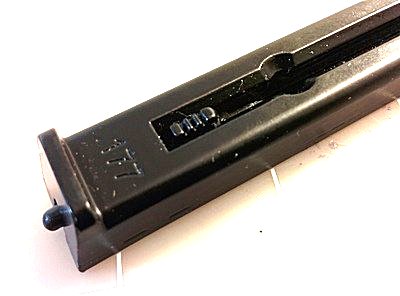
The magazines are made out of metal. They are completely sealed with no way to disassemble.
Compared to other CO2 airsoft guns, where the CO2 canister is in the magazine, the XBG and Combat Zone Enforcer magazines are extremely slim and small. In a way, it makes the pistols even more science fiction like, because there are now magazines today that are this small.
The CO2 canister compartment is in the handgrip. To get to it, you simply pull open the handgrip back. Inside, the compartment is made out of metal (see photo below). It seems that only the outer shell of the XBG and Combat Zone Enforcer is made of out plastic polymer. The internals is all metal.
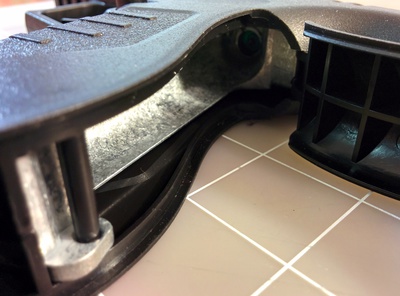
To insert the CO2 cartridge, you have to unscrew the CO2 canister locking screw (see photo below). Counter-clockwise unscrews it. After placing the CO2 canister into the compartment, you screw it down by turning this locking screw clockwise.
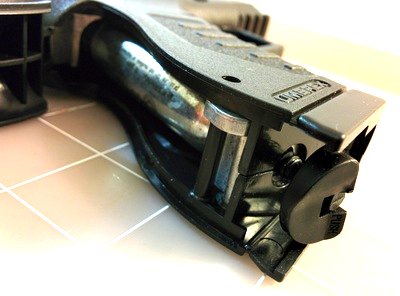
From the experiences I have with CO2 airsoft guns, the Combat Zone Enforce is the only CO2 airsoft gun that doesn't leak. It has sat on the shelf with the very first CO2 canister I secured in it for a month and a half. So far, it still fires airsoft BB with that original CO2 canister.
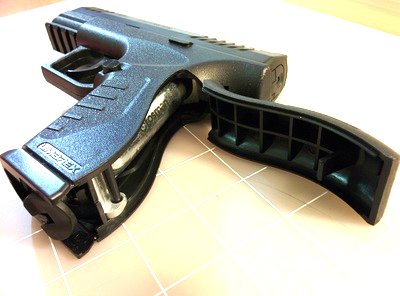
There is a carbine conversion kit for both of these pistol. It is based on the CAA RONI carbine conversion concept. However, it's look has no real firearm counterpart, therefore can be vategorized on the science fiction category. It is actually very neat, because it not only turns your pistol into a shoulder-able gun, but gives your pistol a quad-rail interface system. A fore-grip is also included (see photo below).
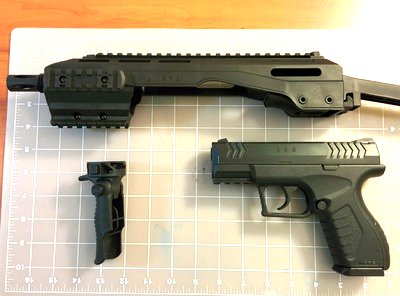
The foregrip is ergonomically designed. I am surprised how comfortable and natural it is to hold. It has a quick release button to allow the foregrip to swivel 90 degrees into and out of position. Two quick release buttons on the Picatinny mount allows you to slide it on and off rail. It's handy for use on multiple guns.

The photo below shows the XBG or the Combat Zone Enforcer installed in the carbine conversion kit. The foregrip is extended for action. The shoulder stock is folded for close-quarters.

The photo below shows the foregrip folded for storage.
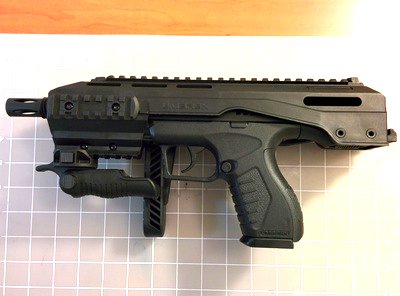
The muzzle has screw threads (see photo below). I suspect you can mount silencers and other accessories on it. But without knowing the thread size and pitch, it's hard to source parts for it.
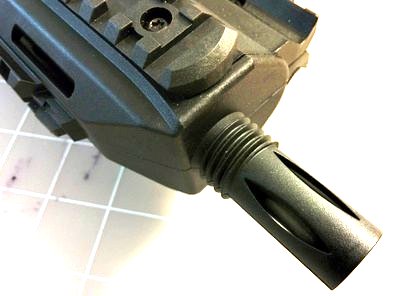
The carbine conversion kit has a shell ejection port (see photo below). The air pistols do not actually eject shell. And in fact the shell ejection port is in the wrong location relative to the simulated shell ejection port on the pistols. It is for aesthetics only.
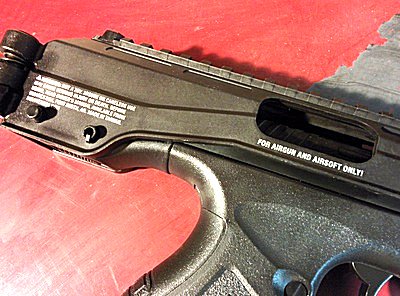
The carbine conversion kit is made out of plastic. However, it's pretty hard and sturdy. It's quite comfortable being wielded. It is an excellent addition to these unique futuristic pistols.